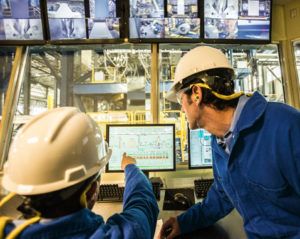Oilfield Services Industry: Downturn to Digital Transformation

The Oil and Gas industry is reeling under the current industry downturn, since the prices of crude oil plummeted in early 2014. Its been more than two years since the prices have remain low with no recovery in sight. To improve profitability of the business, oilfield services companies such as Schlumberger, are looking at digital transformation to re-invent how they do their business — in order to achieve cost optimization and remain profitable during the industry downturn.
“To quickly respond to market changes, oil and gas companies need to reinvent themselves. They need to be the next disruptors.” – Julia King
There’s a huge emphasis on being more efficient. When oil was $100 a barrel, oil and gas companies didn’t worry about efficiency and costs because they were making so much money. But now, it’s a huge issue. The oil and gas industry is again at a crossroads. Reduced demand for crude oil and increasing supply requires companies to optimize current production and extend well life — to do more with less; to be more efficient and more innovative. While waiting for commodity prices to rise, operating costs are being cut, capital projects are being deferred or cancelled and suppliers are under pressure to lower prices. By automating some manual processes, oil and gas firms can improve efficiency, safety, and accuracy, while reducing risk. This means that companies should automate many routine analysis and decision-support processes.
For example, Schlumberger – the world’s largest oilfield services company is transforming its business and operating model by trying to optimize its cost base, so it can provide superior technology that can enable higher production rates, at less cost to the client. Schlumberger’s business model is diversified across geography and product lines of the entire oil and gas exploration and production job cycle. The business model is dependent on delivering innovative technological solutions to customers — Oil Majors such as BP, Shell ExxonMobil etc.; National Oil Companies such as Saudi Aramco, ADNOC etc. — that would help improve upstream companies’ reservoir performance. A critical aspect is to provide these solutions in a cost-effective manner.
Schlumberger’s competitors such as Halliburton, Baker Hughes and Weatherford can provide almost all the services that Schlumberger can provide, but the latter is differentiating itself by being able to improve its asset and people utilization. A reduced cost base is helping Schlumberger to secure projects in the current somber market — by providing discounts — and generate an operating profit.
Technology improving people productivity
For improvement in people productivity, technology is playing a vital role. A single engineer can operate and monitor multiple sites by connecting remotely to the distant field sites via secure desktop connection over the internet. Another aspect of improving people productivity is via automation of key work processes using wearable technology. But can wearables improve operational efficiencies; lead to significant cost savings; and/or make the dangerous, messy, and exceedingly complicated jobs in this sector safer and easier?
Wearables transforming operations in oilfields
When we talk about wearable technology in oil & gas, we are referring to wearable devices that can both collect and deliver data in the field, including Google Glass but especially more rugged smart glasses, such as those by Vuzix and Epson, and also VR (virtual reality) headsets like the Oculus Rift. Other devices include smartwatches and other smart wrist- and armbands, smart helmets, and sensors embedded in clothing designed to detect such things as radiation and/or chemicals. Most promising, however, is the smart glasses + AR (augmented reality) combo, along with the data analytics afforded by this new wave of mobile technology.
So how can wearable tech be applied at, say, a drilling site? Wearables can cut down on response time and total working hours by:
- Improving communication between control staff and on-site workers
- Providing workers with the key information they need at the moment they need it, whether data, schematics, maps, guidelines or instructions
- Enabling advanced, immersive, and remote collaboration, including virtual over-the-shoulder coaching
- Boosting on-the-job training—all hands-free. For instance, via smart glasses a worker can have ready access to interactive equipment manuals while repairing an oil rig or bridge cable; or receive specific directives such as emergency procedures at the point of impact. Wearables can pipe step-by-step instructions and illustrations to new, inexperienced workers; and, allow a worker to show a remote colleague first-person-perspective footage from the field to diagnose and fix problems quickly and efficiently, and thereby helping to eliminate rework.
Thus, smart glasses stand to give energy workers access to real-time information along with the insight and guidance of outside talent and expertise from around the world, enabling greater efficiency and faster decision-making without having to bring in additional resources to remote sites.
Conclusion
Schlumberger has already been testing Glass along with partner Wearable Intelligence. Schlumberger workers are using the technology to handle workflow in places tablets can’t go: Glass guides them through their daily tasks, and gives invaluable, real-time performance metrics back to management. But the challenge that the current technology faces is to mold it for the oilfield operating environment – the technology needs to be rugged and explosion-proof, with the wearable devices running custom software for data security and operable without net connectivity. (788 words)
References:
- http://www.connectedfuturesmag.com/a/S15A35/oil-and-gas-an-industry-ripe-for-digital-transformation/, accessed in November 2016
- https://www.accenture.com/us-en/insight-oil-gas-companies-digital-transforming-work, accessed in November 2016
- http://www.csc.com/oil_and_gas/insights/137108-accelerating_digital_transformation_for_oil_gas_companies, accessed in November 2016
- http://theogm.com/2015/09/17/google-glass-the-smart-wearable-intelligence/, accessed in November 2016
- Big Oil page on Wikipedia: https://en.wikipedia.org/wiki/Big_Oil, accessed in November 2016
- Schlumberger Corporate Media website: http://media.corporate-ir.net/media_files/IROL/97/97513/2015AR/Interactive/transformation-advantage.html, accessed in November 2016
- Schlumberger Corporate Media website: http://media.corporate-ir.net/media_files/IROL/97/97513/2015AR/Interactive/transformation-to-growth.html, accessed in November 2016
- https://brainxchange.events/wearable-technology-industry-series-oil-gas/#, accessed in November 2016
- http://oilpro.com/post/19375/schlumberger-implements-multiskilling-approach-ceo-expects-recove, accessed in November 2016.
- https://open-your-innovation.com/en/2016/03/08/the-uberization-of-heavy-industry-some-thoughts-on-the-oil-gas-case/, accessed in November 2016
- http://www.oilandgaswestafrica.com/google-glass-set-to-make-its-debut-in-schlumberger-operations/#, accessed in November 2016
- http://www.iebmedia.com/ethernet.php?id=10937&parentid=74&themeid=255&hft=88&showdetail=true&bb=1, accessed in November 2016






Great post, EK. I agree that due to the current market situation in Oil&Gas those players need to invest in digital capabilities to stay competitive. You mentioned various ways to do so, like communication, information and training. However, from my experience I know that security is one of the main issues in this industry. Do you know any examples of firms that used digital devices to improve the security of workers? There must be great potential.
EK — very interesting. I suspect these types of advances in technology will add significantly to the safety environment of OFS workers and to the quality of services offered by firms that choose to invest, as Schlumberger appears to be doing.
As we think about improving the cost structure and insulating OFS firms from future dips in crude prices, where do you see the greatest gain? Is it from limiting errors and costly failures in the field? Streamlining training? Reducing the level of skill required in early hires?
I’m generally curious about the organizational impact of this type of technology change. You mentioned “Enabling advanced, immersive, and remote collaboration, including virtual over-the-shoulder coaching.” Will Schlumberger have a central “call center” with managers or specialists who provide this “over-the-shoulder” analysis and feedback to field workers? It feels to me like this is the only viable solution, unless it can be outsourced to a 3rd-party provider. Maybe there’s an opportunity there.
Great post!
Dear RC,
Thanks for your comments.
I do see that the greatest gain is from limiting error and costly failures — as you very rightly mentioned. In fact, the current focus of Chevron and Schlumberger is aligned towards this very goal — to try and reduce failures. Schlumberger’s target is to achieve a 10-fold improvement in operational reliability by 2020.
As for “over-the-shoulder” analyss and feedback to field workers, a mechanism called as remote operations and operations support center, is already in place in Schlumberger. In fact, my last job description prior to school was working as a Operations Support Engineer, monitoring and supporting drilling operations within the Middle East region.
Regards,
EK.
Nice work EK. It would be interest to see how digital capabilities improve operating efficiencies and safety in the drilling sector. I’m wondering though, how much all this technology would prompt distraction among the employees. Essentially, glass and other wearables make it easier to have computer access on site, which would enable employees to discretely check email, social media, etc. on the job. What type of protections could be put in place to allow workers to use these devices without distracting them from demanding tasks and increasing the risk of errors which the technology intended to minimize?